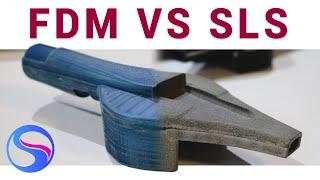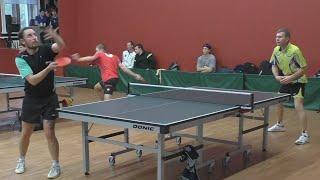
Comparing consumer FDM 3D printing to SLS Nylon with Team Surge AU
Комментарии:

Interesting tests! Consider PP. Difficult to print but very tough and very light vs pla.
Ответить
Hi Michael, my name is Francesco, and I am a 16-year-old guy passionate about 3D printing. About a year ago, I bought my Elegoo Neptune 4, an amazing printer that works very well, and I am happy with the purchase. Unfortunately, every time I turn the printer on and off, the Z-offset changes, and I have to recalibrate it manually. This frustrates me because I’m forced to make a lot of clicks to level the bed. So, I started searching online for a solution, but the automatic calibration either involved a load cell mounted on the nozzle or external hardware that was complicated to install.
So, I came up with a software idea that could automate the whole process. Here’s how it works:
You need to know the offset between the 3 axes, which is the distance between the nozzle tip and the probe for automatic bed leveling. You tell the printer to move to a coordinate near the center of the bed, take a measurement with the probe, and save it. Then, the head should move to the same coordinates but adding the previously recorded offset in X and Y, take another measurement, and save it as well. After the printer has returned to the previous coordinates, it needs to take the two previously saved data points and insert them into the following formula (the first measurement = A and the second = B, the Z-offset probe is the offset between the nozzle tip and the probe on the Z-axis):
(Z-offset probe + (X)) - (Y) + 0.1mm.
The final instruction to give the printer is to set the current Z-axis coordinate as the Z-offset.
Unfortunately, I don’t know how to program in G-code, so if you think this software might work, would you be willing to help me write it?
(If you think it won’t work, could you explain why?)
I hope I was clear. Thank you for your attention, I’ll be waiting for your response to hear your opinion on this matter.
Best regards,
Francesco
Thank you for your attention.

Strange that the ASA had the highest mass, as ASA and ABS typically have a 20% lower density than PLA and PETG
Ответить
I wonder how much variability there is from one piece of balsa to another. As a natural material, variations in grain structure and/or grain orientation could cause variations in your tests. I would have tested perhaps 5 of each, if I had the time and money. I see your conclusions as preliminary due to the small "N"
Ответить
I really like how you trusted the team to communicate their decisions without interruptions by you. This is one of your best videos. Fantastic content I salute you sir! Nothing but respect ❤
Ответить
Would you use the balsa and infuse it with resin?
Ответить
No ABS? It is less dense than nylon, easier to print (compared to SLS), can be vapor smoothed, and although less tough and less rigid than Nylon it has a good impact resistance.
Ответить
Молодцом!
Ответить
If weight is an issue, what about light-weight PLA. I'm not sure how strong it is though. I've never printed with it.
Ответить
When performance is not reduced, go for looks - play mind games with opponents 😉
Ответить
Have u guys tried bambu's new PPA CF or ABS GF ?
Ответить
You know you can FDM print Nylon too. And for the app as I see it PETG might be a good candidate too. Or you could do a hand layup on it with some FG or CF. Or vacuum bag it. Depending on what you got
Ответить
You built a mini version of that crazy medieval thing from fireball! That’s awesome!
Ответить
This was very cool to see some students and their approach to how they're designing their car. Very interesting video! Good luck to the team!
Ответить
Hey Michael, I’ve been thinking about digital fabrication for a while now and wanted to share some insights. Maybe you already experienced these techniques by yourself. When post-machining a 3D-printed part, I’ve noticed that the impressive accuracy shown by calipers doesn’t always carry across the entire surface. This is especially true for resin prints, which tend to shrink during post-curing and over time. When machining, certain areas are deeply affected by the bit, while others remain untouched. That said, with the right bit, you can significantly improve both the part's accuracy and overall aesthetics—perhaps even achieving some aerodynamic improvements.
One interesting approach is to model your 3D print as a rough-machined part by printing it about 0.25mm thicker than the final dimension, then doing a finishing pass with a CNC router. This allows you to cut into the material where the filament layers are compressed, with no air gaps. I’ll admit, I don’t do this often because it takes extra time and requires precise alignment of the part on the CNC. And, to be honest, FDM quality is usually sufficient for most purposes. However, for that contest these students are working on, these techniques could really pay off!
Keep up the great work!

Perhaps my suggestion is against the rules, but, using FEA, you might identify places to drill out the balsa to shave a few grams? Or is the balsa core an "homologated" part?
Ответить
SLS4ALL might be up your alley to check out. It's one of the only sls kits out there that is available to hobbyists/pro-consumers since that one company got acquired by formlabs.
Ответить
It's so cool that this program exists for students!
Ответить
Glad to be able to donate to this team. Super jealous that I never had opportunities like this when I was in school.
Enjoy the experience!

I think one good opportunity was missed here. It is definitely better if you can do it in house. Why did you not FDM print a glass or carbon-filled nylon? I think you would get most of the benefits of the SLS process but be able to keep it in-house.
Ответить
Very cool video. Really love seeing these kids getting involved in things like this.
Ответить
interesting, was that regular polylite or polylite pro version? if it was a regular one it had an incredible impact resistance...
Ответить
The Hacksmith has made an Video about Electroplating what makes it enorm hard, Like undistructable.
Ответить
It's a damn shame Micronics got bought but perhaps it's not a bad thing that SLS machines remain somewhat inaccessible to the average joe. We use a Fuse 1+ 30W at work. Works great and it's surprisingly fast, but it's challenging to pack the parts sufficiently densely to minimize waste. The powder that hasn't been sintered into your part can be reused as long as what you feed the machine is at least 30% fresh powder, which means that if the parts are irregular and don't stack nicely you generate more waste than you are able to reuse. That's why we still use our FDM and SLA machines quite frequently.
Ответить
why must you remind me of the tragedy micronics turned out to be. I just yesterday talked with a local 3d shop owner and he actually stopped selling formlabs machines over how pissed he was about the whole ordeal.
Ответить
Another cool tech competiton for school kids is First Tech Challenge, which is under the umbrella of FirstInspires.
First Tech Challenge is about making a hybrid wheeled robot/drone that has to perform some task that changes each year.
I've been very impressed by every team I'm seen while volunteering.

More STEM content please! This was fantastic to see the next generation follow their passion <3
Ответить
Learn and play. Best of both worlds.
Ответить
2nd😂
Ответить
screw Micronics. that's all
Ответить










